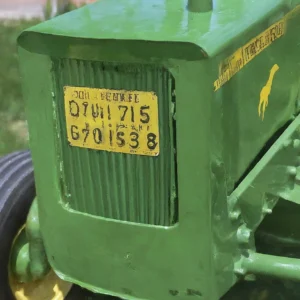The serial number of a John Deere Gator is a crucial identifier that provides insightful details about the vehicle, including its model, factory code, and the year of manufacture. Typically, you can locate the serial number on the frame near the rear wheel or under the seat. Understanding the structure of this serial number can aid immensely in pinpointing the exact year of your Gator.
Importance of Your John Deere Gator Serial Number

When dealing with any kind of machinery, including the John Deere Gator, the serial number is a crucial piece of information. This unique identifier serves multiple essential functions, ensuring that your vehicle is properly maintained and serviced.
One of the primary reasons to know your John Deere Gator serial number is for warranty claims. The serial number helps verify when and where your vehicle was manufactured, which is vital for processing any warranty-related issues.
In addition to warranty claims, the serial number plays a significant role in maintaining accurate service and maintenance records.
Whether you are bringing your Gator in for routine service or addressing a specific issue, the serial number ensures that your service provider has access to the correct history and specifications of your vehicle. This enables technicians to perform precise diagnostics and repairs, ultimately extending the lifespan of your John Deere Gator.
Another critical aspect is parts replacement. The serial number ensures you receive the correct parts tailored for your specific model. Without this unique identifier, you could mistakenly order parts that are incompatible, leading to potential performance issues or even damage.
The John Deere Gator serial number is meticulously structured, often containing information about the model year, manufacturing plant, and a unique sequence number. Understanding this structure can further aid in identifying the exact specifications of your vehicle. Also explore the street legality of John Deere Gator.
Understanding the Serial Number Format
A standard John Deere Gator serial number is composed of several segments, each representing different pieces of information. For example, a typical serial number might look like this: 1M0825GJH0101234. Let’s break down this serial number to illustrate how each part conveys specific details:
- 1M0: This segment generally indicates the manufacturer code. For John Deere, ‘1M0’ is a common prefix.
- 825: The next digits usually denote the model number of the Gator. In this case, ‘825’ refers to a specific model.
- GJ: This part of the serial number represents the factory code, indicating where the Gator was manufactured.
- H: The following character often signifies the configuration or version of the model.
- 0101234: Finally, these digits are the unique identifier for the specific unit, which also includes the manufacturing year. The first digit or couple of digits in this segment can sometimes reveal the year of production.
For example, in the serial number 1M0825GJH0101234, ‘0101234‘ might suggest that the Gator was manufactured in 2010. However, variations can exist based on the model and year. Older models might have different formats, where the year code could be embedded differently within the serial number.
To accurately determine the year of your John Deere Gator, it is essential to refer to the specific model’s serial number format guide provided by John Deere. This ensures that you decode the serial number correctly, considering any variations that may apply to different models or production years.
How to tell what year a John Deere Gator is by the serial number?

Determining the year of manufacture for your John Deere Gator using the serial number is a straightforward process if you follow these steps carefully. To begin, ensure you have the necessary tools and resources at your disposal. You’ll need access to John Deere’s online database or contact information for a local dealer who can assist you further.
Step 1: Locating the Serial Number
The first step in identifying the year of your John Deere Gator is to locate the serial number. Typically, the serial number can be found on a metal plate attached to the frame of the vehicle, often near the engine or driver’s seat. It is crucial to note down this number accurately, as any error could lead to incorrect information.
Step 2: Interpreting the Model Number
Once you have the serial number, the next step is to interpret the model number to identify the series and model type of your Gator. The model number usually precedes the serial number on the metal plate and provides information about the specific series and model. This identification helps narrow down the possible years of manufacture.
Step 3: Using the Production Code
Next, use the production code included in the serial number to pinpoint the exact year of manufacture. John Deere’s serial numbers are designed to include a production code that corresponds to the year the vehicle was manufactured. You can cross-reference this code with John Deere’s official resources or serial number charts available online or through a dealer.
Step 4: Cross-Referencing Information
After decoding the production code, cross-reference the information with John Deere’s official resources to confirm the exact year. Many online databases and dealer resources provide detailed charts that correlate production codes with manufacturing years, ensuring the information you have is accurate and reliable.
Step 5: Verifying Accuracy
Finally, verify the accuracy of the decoded year. Double-check the serial number, model number, and production code against multiple sources if possible. This step ensures that the information is trustworthy and reduces the risk of errors.
Additional Tips:
If the serial number is missing or illegible, do not hesitate to contact John Deere customer support for further assistance. They can often provide guidance based on other identifying features of your Gator. Additionally, local dealers can be invaluable resources in helping you identify the year of manufacture.
Also explore the John Deere Gator High Hours
Step-by-Step Guide to Locating and Decoding Your John Deere Gator Serial Number

Identifying and interpreting the serial number of your John Deere Gator is crucial for maintenance, repairs, and verifying authenticity. This guide will walk you through the process, ensuring that you can locate and decode the serial number with ease.
Locating the Serial Number
The serial number on a John Deere Gator can typically be found in several common locations, depending on the specific model. Here are some primary spots to check:
- Frame: For many models, the serial number is stamped directly onto the frame, often near the rear wheel or the front of the vehicle. Look for a metal plate or a stamped series of numbers and letters.
- Engine: Some models have the serial number embossed on the engine block. Check around the engine housing and the mounting points.
- Under the seat: In certain models, particularly those designed for utility purposes, the serial number might be located under the driver’s seat. Lift the seat and inspect the area for any labels or stamped numbers.
Referencing photographs or diagrams available in the user manual can significantly aid in pinpointing the exact location of the serial number. If you encounter any difficulties, John Deere’s official website or customer service can provide additional support.
Decoding the Serial Number
Once you have located the serial number, the next step is to decode it. The serial number typically consists of a series of letters and numbers, each segment representing specific information about your Gator. Here is a breakdown of the common components:
- Model Identifier: The initial characters usually denote the model of the Gator. For instance, “XUV” often indicates a specific type of utility vehicle.
- Production Year: The midsection of the serial number often includes digits that indicate the year of manufacture. Cross-referencing these digits with John Deere’s production year table can help you identify the exact year.
- Manufacturing Plant: The final segment usually refers to the factory where the Gator was assembled. This can be a useful detail for tracking production origins.
Recording and Storing the Serial Number
It is essential to record and store your John Deere Gator serial number securely. Maintaining a physical copy, such as a written note or a photograph, can be very effective. Additionally, storing a digital copy on your computer or cloud storage ensures that you can access it anytime, even if the original label fades or becomes damaged.
By following these steps, you can easily locate, decode, and store your John Deere Gator serial number, ensuring that you have all the necessary information for maintenance, repairs, or verification purposes.
Decoding the John Deere Gator 17-Digit VIN
A Vehicle Identification Number (VIN) is a unique code used to identify individual motor vehicles. For John Deere Gators, understanding and decoding the 17-digit VIN is crucial for obtaining detailed information about the specific unit. The 17-digit VIN is a standardized format recognized globally, ensuring consistency and accuracy in vehicle identification.
- The 17-digit VIN is divided into three main sections: the World Manufacturer Identifier (WMI), the Vehicle Descriptor Section (VDS), and the Vehicle Identifier Section (VIS). Each section provides specific details about the vehicle.
- World Manufacturer Identifier (WMI): The first three characters of the VIN represent the WMI. For John Deere Gators, these characters identify the manufacturer and the country of origin. For instance, ‘1M0’ is a typical WMI for John Deere, indicating that the vehicle was manufactured in the United States.
- Vehicle Descriptor Section (VDS): The next six characters (four through nine) make up the VDS. This section provides information about the vehicle’s model, body style, engine type, and other attributes. For example, the characters may indicate whether the Gator is a utility, turf, or recreation model, as well as specific engine configurations and other significant specifications.
- Vehicle Identifier Section (VIS): The final eight characters (ten through seventeen) form the VIS. This section includes the vehicle’s production year, assembly plant, and a serial number unique to that specific unit. For example, the tenth character represents the model year, which is standardized across the industry (e.g., ‘A’ for 2010, ‘B’ for 2011, and so on).
To locate the VIN on your John Deere Gator, check areas such as the frame, the dashboard, or the engine block. The exact location may vary depending on the model and year of manufacture. Once you have identified the VIN, you can decode it using the guidelines above to reveal detailed information about your Gator.
For example, a VIN such as ‘1M0833DMJEJ123456’ can be broken down as follows: ‘1M0’ (manufacturer and country), ‘833DMJ’ (model and specifications), and ‘EJ123456’ (production year, assembly plant, and unique serial number). By understanding these segments, you can accurately interpret the specifics of your John Deere Gator.
Also explore the John Deere Gator 835M Problems
Decoding the John Deere Gator 13-Digit VIN: A Step-by-Step Guide
The 13-digit VIN format is prevalent among older models of John Deere Gators. Understanding the history and rationale behind this format is essential.
Unlike the modern 17-digit VIN, which adheres to standardized international practices, the 13-digit VIN was primarily used by manufacturers before such global standards were in place.
This format encapsulates crucial information about the vehicle, such as its origin, model, and production specifics, albeit in a more condensed form.
To decode a John Deere Gator 13-digit VIN, follow these steps:
Step 1: Locate the VIN
The VIN is typically stamped on a plate affixed to the frame or under the dashboard. For John Deere Gators, common locations include the frame near the steering column or the engine compartment. Ensure the VIN is clean and legible for accurate decoding.
Step 2: Break Down the VIN
The 13-digit VIN can be divided into distinct segments, each representing specific information:
Manufacturer Identifier (Digits 1-3)
The first three digits denote the manufacturer. For John Deere Gators, this segment usually starts with “1M0,” indicating the vehicle was built by John Deere.
Model Identifier (Digits 4-7)
The next four digits specify the model. This segment helps identify the exact type of Gator, such as the HPX or XUV series. Refer to John Deere’s model identification chart for precise decoding.
Production Year (Digit 8)
The eighth digit indicates the production year. This alphanumeric character corresponds to a specific year, following a predefined code chart. Understanding this code is crucial for verifying the vehicle’s age.
Production Plant (Digit 9)
Digit nine reveals the manufacturing plant. John Deere has various assembly locations, and this digit helps pinpoint where the Gator was built.
Serial Number (Digits 10-13)
The last four digits are the serial number, which uniquely identifies the individual vehicle. This number is critical for maintenance records and verifying the vehicle’s authenticity.
Conclusion:
By following this guide and using the available tools and resources, you should be able to determine the production year of your John Deere Gator with confidence. Understanding how to decode the serial number not only helps in identifying the year but also aids in tracking maintenance records and ensuring the longevity of your Gator

